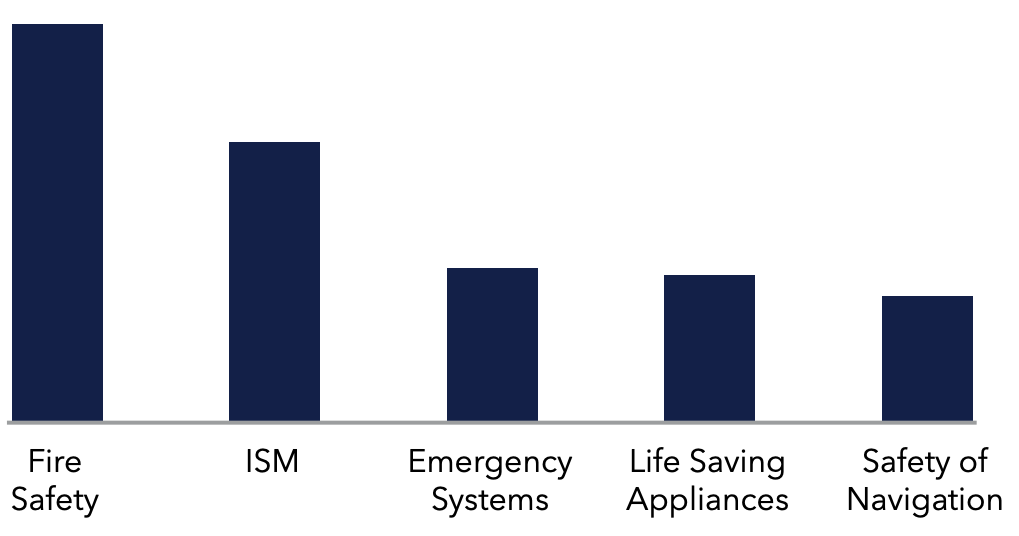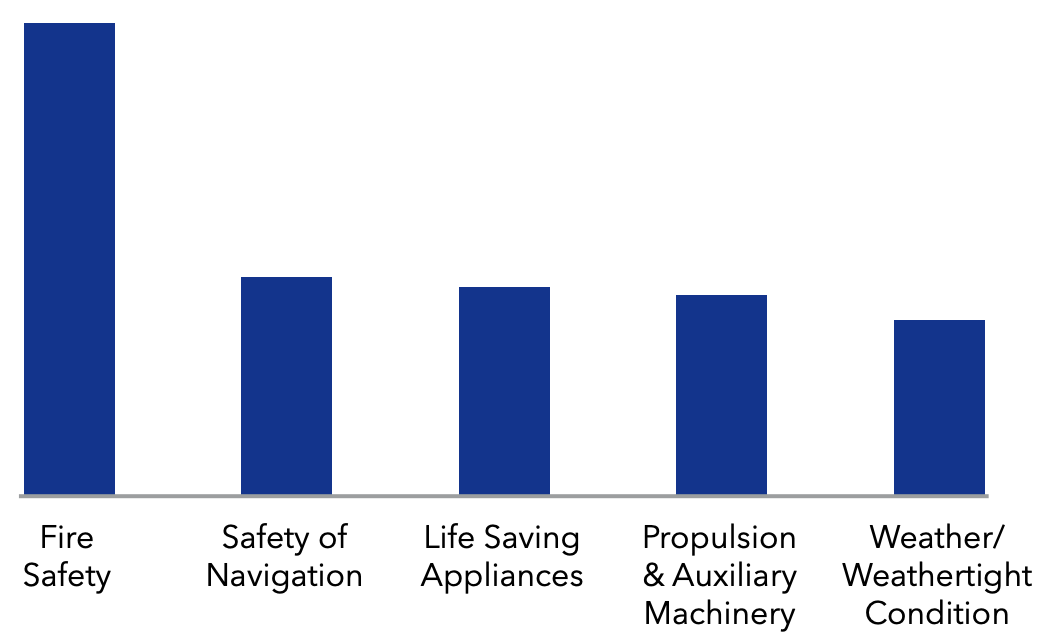Port State Control – A summary of Q2 detentions
To support our customers in ensuring safe vessel operation and minimizing potential downtime, this news highlights the most frequent detainable and ISM-related deficiencies identified during PSC inspections of DNV-classed vessels in Q2 2025. It complements our recent news (15 July and 5 August) on the upcoming PSC Concentrated Inspection Campaign (CIC) on Ballast Water Management to help operators prepare effectively.
Relevant for ship owners and managers as well as document holders.
Detentions
In the 2nd quarter of 2025, 73 DNV-classed vessels were detained. Most of those detentions, more than 80%, were recorded in the Tokyo and Paris MoUs, and the majority of the detentions involved containerships and bulk carriers:
Figure 1 – Detentions of DNV vessels in Q2 2025 by vessel type
Detainable deficiencies
A total of 252 detainable deficiencies were recorded during the PSC inspections, leading to 73 detentions. The categories of the most recorded detainable deficiencies are shown in the following figure:

Figure 2 – Most detainable deficiencies by category
The details of the deficiency categories are as follows (apart from ISM-related detainable deficiencies, which are further detailed below):
Fire Safety:
- Means of control of openings/pumps in machinery spaces (mainly quick-closing and isolation valves)
- Fire dampers and fire doors
- Fixed fire-extinguishing installation
- Fire detection systems
Emergency Systems:
- Emergency source of power – emergency generator
- Emergency fire pump and its pipes
- Operational topics (muster lists, fire drills, crew familiarization)
Life Saving Appliances:
- Life and rescue boat
- Launching arrangements
- Maintenance of life-saving appliances
Safety of Navigation:
- Lights, shapes, sound signals
- Magnetic compass
- Voyage data recorder
A special comment should also be given to the rigging of pilot ladders, which fall under the “Safety of Navigation” category. An incorrectly rigged or broken transfer arrangement poses a significant danger to anyone using it. PSC Officers (PSCOs) may conduct follow-up inspections outside of regular timeframes if they receive information about such deficiencies.
ISM-related deficiencies
ISM-related deficiencies remain one of the primary reasons why DNV-classed vessels are detained. These deficiencies are not isolated cases but are often the result of multiple other, potentially non-detainable, deficiencies. Collectively, these causes may indicate a broader challenge with the implementation of a vessel’s ISM system.
PSC inspections include checks on the ISM system to confirm that conditions on board and the operation of the vessel align with international conventions and legal requirements. By examining how the ISM system is applied in practice, PSC inspections can help identify systemic weaknesses that could compromise safety or lead to non-compliance.
The Paris MoU, for example, describes ISM-related deficiencies as deficiencies where ”there is a failure, or lack of effectiveness, of the implementation of the ISM Code” (Paris MoU – General principles applied in an inspection, 3.5). If a PSCO in the Paris MoU considers a deficiency to fulfil the above requirement, it is clear grounds for the PSCO to carry out a more detailed inspection. If during such inspection the PSCO concludes that the deficiencies provide objective evidence of a (serious) failure of the ISM system on board, the PSCO will report a (possibly detainable) ISM deficiency (Paris MoU – Guidelines for the Port State Control Officer on the ISM Code, 1.2). Hence, the category “Fire Safety”, for example, may be considered both a “detainable deficiency” as well as an “ISM-related deficiency”. When isolated, a deficiency may be non-detainable, but because it can lead to a deficiency in the ISM system, which in turn can be detainable, it may be an indirect cause for detention.
The following figure shows the most frequent ISM-related deficiencies recorded by category during PSC inspections on board DNV-classed vessels worldwide:

Figure 3 – ISM-related deficiencies by category
Within these categories, the following sub-categories stand out in their number of occurrences:
Fire Safety
- Fire doors/openings in fire-resisting divisions
- Fire dampers
- Fire detection
Safety of Navigation
- Lights, shapes, sounds signals
- Voyage or passage plan
- Voyage data recorder
Life Saving Appliances
- Lifeboats
- Rescue boats
- Rescue boat inventory
Propulsion & Auxiliary Machinery
- Auxiliary engine
- Propulsion main engine
- Bilge pumping arrangements
Water/Weathertight Condition
- Covers (hatchway, portable, tarpaulins, etc.)
- Cargo and other hatchways
- Windows, side scuttles, deadlights
- Manholes / flush scuttles
Part of maintaining a well-implemented ISM system is clear and consistent communication between the ship and shore teams, alongside a thorough review of reports and audit outcomes.
Recommendations
By analysing audit findings, operators can identify patterns early and take corrective actions. When needed, root cause analysis as per the ISM Code helps resolve underlying issues and prevent recurrence.
Use DNV’s PSC Planner to prepare for inspections. Its checklists highlights focus areas based on past deficiencies, port-specific priorities, the DNV Top 18, and the CIC questionnaire, when relevant.
References
- IMO Res. A.1185(33) Procedures for Port State Control 2023
- PSC information and access to the PSC Planner on the DNV PSC webpage
- Paris MoU – General principles applied in an inspection
- Paris MoU – Guidelines for the Port State Control Officer on the ISM Code
- DNV news from 15 July 2025
- DNV news from 5 August 2025
- DNV webinar on 2 September, focus in the CIC on BWM, register here
Contact
- For customers:
DATE - Direct Access to Technical Experts via My Services on Veracity. - Otherwise:
Use our office locator to find the nearest DNV office.

